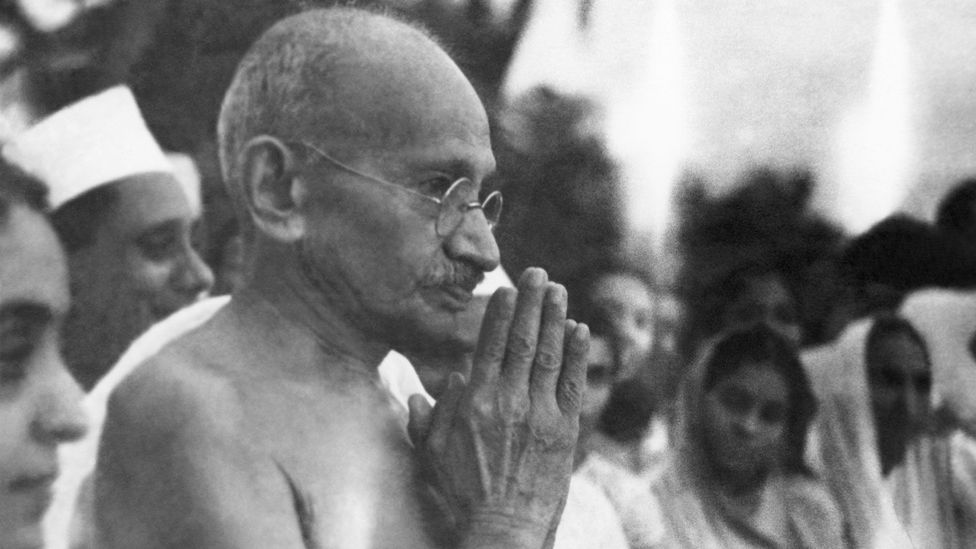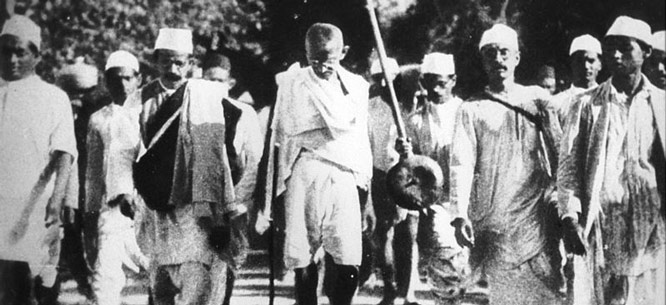Gandhi Used the Term Satyagraha to Describe
Civil disobedience soon spread to other parts of India and over 60000 people were arrested. Gandhi and his followers in India.

The Birthplace Of Gandhi S Peaceful Protest Bbc Travel
It suggested that if the cause was true and if the struggle was against injustice then physical force was not necessary to fight the oppressor.

. Psychology questions and answers. Start studying Gandhi-Satyagraha Test. Sentence Implied Meaning On the other hand Gandhi gained respect in the West.
Satyagraha Sanskrit and Hindi. Furthermore Gandhi gained respect in the West. This contrast hints that elsewhere Gandhi may not have had respect.
It may also help to keep in mind that the terms Satyagraha and nonviolent action though often used one for the other dont actually refer to the exact same thing. Satyagraha was a non-violent method of mass agitation against the oppressor. A triangle with about 5 different.
Satyagraha is a Sanskrit word that comes from the roots satya meaning truth and agraha meaning insistence It can be loosely translated to mean insistence on truth or holding onto truth The concept of satyagraha was developed and introduced by Mahatma Gandhi who used it in the Indian independence movement and earlier in his struggles for Indian. Gandhi introduced a new weapon in the Indians campaign for justice. Satyagraha was a powerful weapon against injustice and exploitation of colonised peoples.
Terms in this set 30 British Imperialism in India was from. It does not have a legalconstitutional structure instead it reads more like a manifesto. Satyagraha is a Hindi word which means insisting on truth.
In that year his caste of Modh Baniyas threatened to excommunicate him if he went to England for according to custom travelling overseas meant losing ones caste. Learn vocabulary terms and more with flashcards games and other study tools. Satyagraha is sometimes used to refer to the whole principle of nonviolence where it is essentially the same as ahimsa and sometimes used in a marked meaning to refer specifically to direct action that is largely obstructive for example in the form of civil disobedience.
It is the weapon of the bravest and the strongest. Subsequently the Salt Satyagraha was initiated by Mahatma Gandhi on 12 March 1930 and what followed gave impetus to the Indian independence movement and sparked off the nationwide Non-Cooperation Movement. On the beach Gandhi defied the Salt Act by reaching down and lifting up a lump of natural salt from the mud.
When in a meeting of Europeans I found that the term passive resistance was too narrowly construed that it was supposed to be a weapon of the weak that it could be characterized by hatred and that it could finally manifest itself as violence I had to damur to. Satyagraha was a novel method of mass agitation. Gandhi was arrested on May 5.
Origin of Satyagraha Term and Influences Gandhi was in need of a term to connote the revolution against the British imperialists that he organized in South Africa. Satyagraha in a just cause is vain if the men espousing it are not determined and capable of fighting and suffering to the end and the slightest use of violence often defeats a just cause. The birth of Satyagraha.
If you return injury with injury then injury goes further and forever - Abid Ballou. Holding onto truth concept introduced in the early 20th century by Mahatma Gandhi to designate a determined but nonviolent resistance to evil. There is a connection between ahimsa and satyagraha.
Through non-violent methods a Satyagraha could appeal the. Satyagraha loosely translated as insistence on truth satya truth. Passive resistance his first.
With this he said I am shaking the foundations of the British Empire. The method suggested that if the cause was true if the struggle was against injustice there is no need for physical force to fight the oppressor. Read the following examples and then choose one more transition word to use and describe how it changes the meaning of the sentence.
It encompassed non-violent modes of protest against the majestic policies of the British. This concept also aims at furtherance of love and self-purification. When in a meeting of Europeans I found that the term passive resistance was too narrowly construed that it was supposed to be a weapon of the weak that it could be characterized by hatred and that it could finally.
The resolution was a short 750-word document. It represented not physical force but pure soul force. That weapon satyagraha was the culmination of a profound development in Gandhi himself.
Satyagraha was a novel method of mass struggle introduced by Mahatma Gandhi. It was first introduced by Mahatma Gandhi in South Africa in 1894 AD In practice this evil appeared as a strong but non-violent resistance to the particular. Gandhis concept of Satyagraha is an integrated concept and includes truth non-violence non-stealing chastity or Brahmacharya poverty or non-possession bread labour fearlessness control of the palate Asvada tolerance Swadeshi and removal of untouchability.
There can be no Satyagraha in an unjust cause. I Gandhiji used the Satyagraha technique successfully against injustice in South Africa. According to Gandhi Satyagraha can be adopted by anybody.
Satyagraha is a synthesis of Satya meaning truth and Agraha means to persuade. Non-peaceful means to an ends not right. Noun pressure for social and political reform through friendly passive resistance practiced by M.
Chose Satyagraha as their main tactic. Satyagraha excludes the use of violence in any shape or form whether in thought speech or deed. In Gujarati also we used the English phrase passive resistance to describe it.
Agraha insistence or holding onto truth1 or truth force is a particular philosophy and practice within the broader overall category generally known as nonviolent resistance or civil resistance. Truth force a term used by Gandhi to describe peaceful boycotts strikes noncooperation and mass demonstrations to promote Indian independence. Satyagraha is really one special form of nonviolent action-Gandhis own version of it.
Describe how Mohandas Gandhi used Satyagraha effectively to fuel the independence movement in India. Gandhi explained the meaning of satyagraha as an increasing awareness of dharma or truth and this awareness he says first came to him in 1887. What is meant by Satyagraha.
In Gandhis terminology Satyagraha-Truth-force-was an outgrowth of nonviolence. Gandhis satyagraha became a major tool in the Indian struggle against British imperialism and has since been adopted by protest groups in other countries. According to this philosophy satyagrahis.
Through this mechanism Gandhi aimed at resisting any kind of unjust impure or untruthful acts. In Gujarati also we used the English phrase passive resistance to describe it. Satyagraha can be regarded as a vindication of truth by taking self-suffering in the form of love.
It is an antidote for coercion. The reason why satyagraha found favour among the Indians was that it marshalled their inner most resources and thereby gave them the dignity. The idea of Satyagraha emphasized upon the power of truth and the need to search for truth.

How Did Gandhi Win Lessons From The Salt March Dissent Magazine

Satyagraha Movement Essay Important Notes Studiousguy

What Was The Champaran Satyagraha Of 1917

When Gandhi S Salt March Rattled British Colonial Rule History
Comments
Post a Comment